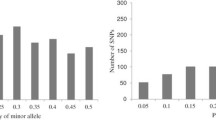Abstract
The effects of breeding on allele frequency changes at 82 restriction fragment length polymorphism (RFLP) loci were examined in two maize (Zea mays L.) populations undergoing reciprocal recurrent selection, Iowa Stiff Stalk Synthetic and Iowa Corn Borer Synthetic #1. After 12 cycles of selection, approximately 30% of the alleles were extinct and 10% near fixation in each population. A test of selective neutrality identified several loci in each population whose allele frequency changes cannot be explained by genetic drift; interpopulation mean expected heterozygosity increased for that subset of 28 loci but not for the remaining 54 loci. Mean expected heterozygosity within the two subpopulations decreased 39%, while the between-population component of genetic variation increased from 0.5% to 33.4% of the total. Effective population size is a key parameter for discerning allele frequency changes due to genetic drift versus those resulting from selection and genetic hitchhiking. Empirical estimates of effective population size for each population were within the range predicted by the breeding method.
Similar content being viewed by others
Author information
Authors and Affiliations
Additional information
Received: 10 June 1998 / Accepted: 29 April 1999
Rights and permissions
About this article
Cite this article
Labate, J., Lamkey, K., Lee, M. et al. Temporal changes in allele frequencies in two reciprocally selected maize populations. Theor Appl Genet 99, 1166–1178 (1999). https://doi.org/10.1007/s001220051321
Issue Date:
DOI: https://doi.org/10.1007/s001220051321




